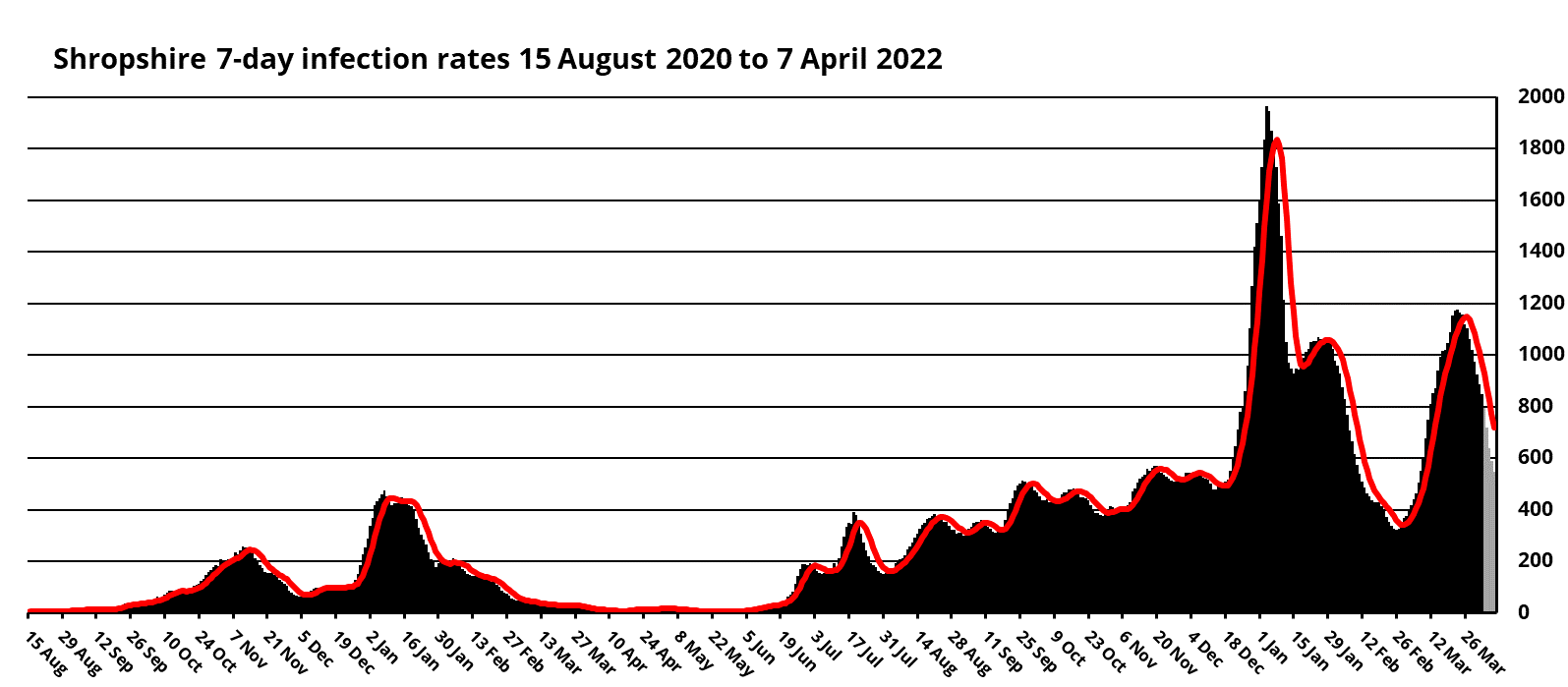Cases in England and in Shropshire are continuing to fall. We must though be cautious about numbers after the government withdrew free testing and closed testing centres across the country at the end of last month. In Shropshire, for example, PCR testing dropped by more than 70% in a week. However, it seems clear that the trend continues to be downwards.
Despite Omicron being milder than the previous Delta variant of Covid-19, the number of patients in hospital with Covid-19 in Shropshire has been rising rapidly in recent weeks. That, along with higher than normal levels of staff sickness, has led the county’s health managers or declare the fourth critical incident this year, an incident that is now entering its second week. The queues of ambulances backing up outside the county’s A&E departments is at an all time high, with half of ambulance crews waiting more than an hour to hand over their patients.
Covid symptoms
The NHS official list of Covid-19 symptoms has been extended to cover nine new symptoms, including a sore throat, fatigue and headache. The full list, which includes the three longstanding symptoms of a fever, a new and persistent cough, and a loss or change in taste or smell, means that Covid-19 symptoms are often undistinguishable from those of a heavy cold or flu. There are reports that the BA.2 variant of Omicron – which is now the dominant strain of Covid-19 in Shropshire and across the country – does not lead to a loss of taste and smell previous variants did. That makes it harder to detect. The only way to be certain if anyone has Covid-19 is to test.
Covid Testing
However, free testing has ended for most people. They must now purchase lateral flow tests (LFT) and these can sometimes be hard to get from local pharmacies. All testing centres for the PCR test in our area closed at the end of last month. In the first week of April, there were 334 PCR tests in Shropshire. The week before, there were 1,158 tests. LFT tests dropped from 1,842 to 1,266 over the same period.
Cases began falling before the reduction in testing and that trend is continuing even though there is now greater uncertainty about the level of Covid-19 cases.
How much Covid is there around?
The Office of National Statistics estimates that around 7.6% of people in England had Covid-19 in the week end 2 April. The world-renowned REACT programme at Imperial College estimated that 6.4% of the population in England were infected between 8 and 30 March. In line with its policy of living with Covid – some might say the policy is living with Covid while ignoring it – the government has ended the REACT programme.
Around 11% of cases in England during the seven days to April 7 were reinfections.
For England as a whole, for Shropshire, Telford & Wrekin and for Ludlow rates are thankfully falling.
Hospitals struggling
There have been four critical incidents declared at SaTH this year, with the latest Shropshire wide incident still ongoing after nearly two weeks.
Bed occupancy by patients with Covid-19 has grown more quickly at SaTH than nationally. Last Thursday, there were 160 patients Covid-19 occupying beds in the RSH and PRH. This has been growing more quickly in recent weeks in than nationally. In the seven days to 5 April, around 150 beds were occupied at SaTH each day. For the seven days before, it was 100 beds and for the week before that, 80 beds.
This puts pressure on bed availability, though a daily average of 70 general and acute beds were still available in the week to 5 April.
A bigger issue than beds is the availability of staff. Last week, around 8% of staff were off sick, twice the normal rate.
Ambulances handover delays soar
The problems at SaTH are having an impact on already poor ambulance handover times which are at the highest level since the beginning of December and the highest level for five years. This is despite there being fewer ambulances arriving than average. Since December, an average 100 ambulances a day have been arriving at the RSH and PRH A&Es. In the week to 3 April, an average of 80 ambulances a day were checking in. But in the last week, nearly three-quarters of handover from the ambulance crew to A&E staff have faced delays of 30 minutes or more (72%). Half of ambulances have faced delays of one hour or more (51%).
Handover delays are a national problem that is affecting patient health. Dr Ian Higginson, Vice President of The Royal College of Emergency Medicine, said recently:
“It is vital that ambulances return to active service whenever possible and safe to do so. Delaying ambulance handovers should be a last resort. Holding patients in ambulances leads to unnecessary delays to their care, leaving seriously ill or injured patients in the community requiring an ambulance to wait longer. Ambulance handover delays are almost entirely caused by dangerous crowding in Emergency Departments. The root cause of these problems is “exit block” where there are delays for patients to be admitted to inpatient beds.”
Although handover delays are a national problem, as the graphs above show delays are much worse in Shropshire.










I wish this was true but I would be very cautious. As you note, testing rates are plummeting but ONS estimates are that cases rates are stable at best, 1 in 13 in England. And 1 in 37 have long covid. Basically it isn’t safe to socialise indoors unless you are prepared to risk disease. Wear an ffp2 mask (not fabric, nor surgical) and open the windows.
Our hospitals and medical services are in crisis, as are supply chains. Anyone sick or injured really takes their chances right now.